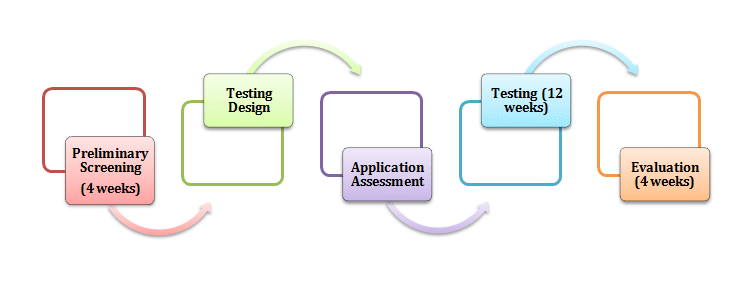RBI Releases Draft Framework for Regulatory Sandbox to Create Innovation Test Lab for Fintech

The Reserve Bank of India has come out with the enabling framework for regulatory sandbox on 24th April 2019 to help Fintech Startups. Department for Promotion of Industry and Internal Trade (DPIIT) has acknowledged Fintech Startups to take part in Sandbox testing. While, crypto startups expelled from the sandbox testing not even in the draft phase. The Sandbox testing process will start with around ten to twelve selected entities with the main focus on financial inclusion, digital KYC and payments and lending etc.As per the RBI, the end to end sandbox process should be completed within six months.
Now, let’s discuss the framework for regulatory sandbox in details;
What is Regulatory Sandbox?
This is an evolutionary phase for Fintech startups in India in terms of payments; insurance and lending. Now, banking services are rendered through mobile. The Reserve Bank of India (RBI) came up with draft ‘Enabling Framework for Regulatory Sandbox’ acknowledging the latest innovations by Fintech startups. This framework will permit Fintech startups to test within a regulatory sandbox (RS).
As per the draft, Fintech startups may still need regulatory approvals in respect of their products, services, or technology for wider application even after successful sandbox testing.

It permits financial entities to test their product in a controlled environment before introducing it on wider level. Therefore, for market participants it is mainly a formal regulatory programme in order to test new products, services, business models with customers in a live environment subject to certain safeguards.
The concept of ‘innovation hub’ has also been discussed in
the Working Group Paper of RBI which provides guidance to the regulated or
unregulated firms in identifying the legal issues as well as in navigating the
regulatory framework.
means live testing of new products or services in a restricted regulatory
environment in relation to which regulators might allow certain regulatory
relaxations for the purpose of the testing.
Why it has been introduced?
This
draft framework for regulatory sandbox came into force on the recommendation of
an inter-regulatory working group set up by the RBI in July 2016. In February 2018, this inter-regulatory
working group submitted its report and recommended an introduction of draft framework
for a ‘Regulatory Sandbox’ within a well-defined space and duration. Therefore
this step had been taken with a view to respond to the dynamics of the swiftly growing Fintech scenario.
In this group, there are members of Reserve Bank of India (RBI), Securities Exchange Board of India (SEBI), Insurance Regulatory and Development Authority (IRDA), Pension Fund Regulatory and Development Authority (PFRDA), National Payments Corporation of India (NPCI), Institute for Development and Research in Banking Technology (IDRBT), banks and rating agencies set up by the RBI in July 2016.
Role of Regulatory Sandbox
(RS)
The Regulatory Sandbox (RS) will permit carrying out field tests with the objective of collecting facts on the basis of advantages provided by new financial innovations to the regulators, innovators, financial service providers and customers. Additionally, it will also allow monitoring the risk involved. It provides a way to the regulator to engage with the network to develop innovation-enabling and responsive regulations in respect of financial products.
How it will take place?
The regulatory sandbox will take place within a well-defined space and duration for which requisite regulatory guidance will be provided by the RBI. This is mainly to enhance efficiency, control risk, and to generate fresh opportunities for clients.
What is Covered Under the Draft Guidelines?
The guidelines issued by RBI on regulatory sandbox highlights the role of the proposed regulatory sandbox (RS), its benefits & disadvantages along with the object of setting up the regulatory sandbox (RS). RBI has also asked for comments from stakeholders on the draft guidelines by the 8th May.
Target Applicants
For entry to the regulatory sandbox, the target applicants
include fintech firms which fulfill the eligibility criteria prescribed
for start-ups by the government. While, such entity must possess minimum net
worth of Rs. 50 lakh as per its latest audited balance sheet. An applicant needs
to emphasize how the existing gap would be addressed in the financial system
through its product/service. It has to express that there is a relevant
regulatory barrier in its operation.
Eligibility
Criteria of an Applicant
As we discussed above for entry in the RS, an applicant can
be Fintech firm meeting the prescribed criteria. For participating in the regulatory
sandbox (RS), the guidelines lay down the eligibility criteria.
The main object of the RS is to promote the innovation where
- There is an absence of regulations
- There is a requirement of temporarily ease the
regulations for the proposed innovation, and - The proposed innovation assures easing the delivery
of financial services.
Initially, the testing process will begin with the ten to twelve selected entities through a comprehensive selection process. Under the ‘Fit and Proper criteria” details are given for selection of participants in the regulatory sandbox (RS).
Following below mentioned conditions must be satisfied by the entities:
- The entity should be a company incorporated in India
which should be a “Start up”. - There is a requirement of minimum net worth of
Rs 50 lakhs as per the latest audited balance sheet of the entity. - The promoters/ directors of the company must fall
under the prescribed fit and proper criteria and a declaration should be made
to that effect. - A satisfactory conduct of the bank accounts as
well as the entity’s promoters/directors. - A reasonable CIBIL score of the promoters/directors
of the entity. - An applicant should display their
product/services as they are ready for deployment in the market. - To ensure compliance with regulations on
consumer data protection and privacy, an entity should reflect arrangements and - To ensure safety of data, there should have adequate
safeguards with entity related to the IT system.
What is the Object of Enabling Framework for Regulatory Sandbox?
The main object of the regulatory sandbox (RS) is to promote innovations where there is absence of governing regulations or where there is a requirement of temporarily easing the regulations for enabling the proposed innovation or where the proposed innovation reflects easing effective delivery of financial services in a significant manner.

Design Features of the Regulatory Sandbox (RS)
End-to-end sandbox process may run by the RS with the restricted number of entities in each cohort testing their products in a prescribed time. The RS shall focus on the areas such as financial inclusion, payments, digital KYC, etc. Ordinarily it should be completed within the time frame of 6 months.
Under RS, following could be considered for testing:
- Retail payments
- Money transfer services
- Market place lending
- Digital KYC
- Financial Advisory Services
- Smart contract
- Cyber security products, etc
While, for testing under RS, the innovative technology which
could be considered would be the following:
- Data analytics
- API services
- Applications using block chain
- Mobile technology applications
Regulatory
Requirements for RS Applicant and Exclusions from RS
Here are some of the mandatory regulatory requirements which
need to be followed by the applicants:
- Customer Privacy and Protection of Data
- Transactions Security
- KYC/ AML/ CFT requirements
- Secure storage of and access to payment of
stakeholders, and - Statutory requirements
However in case the proposed financial service is similar to a product/service/technology which is being offered in India, such entity would not be suitable for RS except when the applicant show that either a different technology is usefully applied or the same technology is being used in a more efficient manner.
Thus, prescribed regulations have designed an indicative
negative list of products/ services/ technology which are not accepted for testing.
This negative list includes businesses in connection with credit registries,
credit information, crypto-currency, initial coin offerings and chain marketing
services.
Following below mentioned are put on the negative list of the
RBI:
- Credit Registry
- Crypto currency/Crypto assets services
- Credit Information
- Initial Coin Offerings
- Trading/investing/settling in crypto assets
- Chain marketing services, and
- Product/services banned by the regulators or the
Government of India
Extending
or Exiting RS
If the extension of the sandbox period is required by the sandbox
entity, it shall apply to the RBI within a period of one month before the
expiration of the sandbox period.
Moreover, RBI can cancel the regulatory sandbox testing at its sole discretion if it finds that intended purpose is not achieved or when the entity is unable to comply with the appropriate regulatory requirements. An entity may also exit at its own discretion from the Regulatory Sandbox (RS) by informing the RBI within a one week in advance.
Boundary Conditions, Transparency, and Consumer Protection
For the proposed financial services, there must be a well-defined
space and duration. For the RS boundary conditions shall include the start and
end date, target customer type, limit the customers involved, cap on customer,
and transaction ceiling.
Moreover to ensure transparency, the entire RS process shall be communicated by the RBI on its website. The sandbox entity shall ensure that all the existing obligations are met and liability of the entity towards its customers is not affect by entering into an RS.
Stages
Involved in Sandbox Process
The stages involved in the regulatory sandbox are as
follows:
- Preliminary
Screening (4 weeks)
It shall be ensured by the Fintech that the objectives and principles are clearly understood by the applicant. Application received is shortlisted on the basis of meeting the eligibility criteria.
- Testing
Design (3 weeks)
Under this, Fintech unit finalizes the test design through interacting
with the applicant and for evaluating the risk or benefits it shall identify
the outcome metrics. This phase is lasts for three weeks.
- Application
Assessment (3 weeks)
Under this, Fintech unit vets the test design and regulatory
modifications are proposed if any.
- Testing
(12 weeks)
If we talk about the maximum tenure, the testing may last
for 12 weeks. Under this, an empirical evidence is generated to evaluate the
test conducted.
- Evaluation
(4 weeks)
Under this, RBI confirms the final evaluation of the outcome of testing the products/ services/ technology. The outcome report is evaluated by the RBI and makes decision regarding the viability of the product/service under RS.

Statutory and Legal Issues
If the applicant is permitted into the RS by the FTU, an appropriate
regulatory support will be provided to the entity by RBI in the form of specific
regulatory requirements relaxation during the duration of the RS.
However, if any liability arises from the process then RBI shall not bear and it has to be borne by the entity alone.
Further, an entity has to ensure that it fully comply with all the relevant regulatory requirements on the completion of the RS process.
Crypto
Startups Barred From the Regulatory Sandbox
As per the guidelines, such startups which are offering crypto solutions and ICOs are not allowed to test regulatory sandbox. While, block chain-based innovations are allowed by the RBI other than crypto in certain areas.
Takeaway
Fintech Startups are welcoming the regulatory sandbox. It will bring new revolution in the Fintech Sector. Also with this, we will come across new innovations in the financial domain. It is an innovative step taken in the right direction. However, there are certain conditions which restrict the operations of regulatory sandbox. We will keep a close eye on upcoming notifications in this regard.
The post RBI Releases Draft Framework for Regulatory Sandbox to Create Innovation Test Lab for Fintech appeared first on Enterslice.
